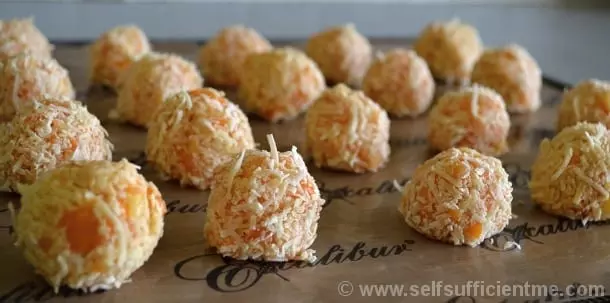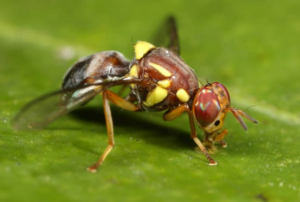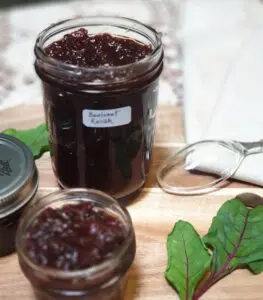Introduction (this article was revised Feb 2013)
Tamarillos are currently in-season in my part of the world (as at the writing of this article) and I've been experimenting with different ways to eat them. If you are not sure what a tamarillo actually is then you can read more about the plant and its fruit in my tamarillo article.
In this post, I'm going to write about a recipe I recently made up which includes tamarillos and pineapple; in fact, apart from coconut the recipe doesn't have any other ingredients so it's a true raw food recipe. I'm also proud to say this recipe was featured on Tess Masters site AKA The Blender Girl from Healthy Blender Recipies – you can visit her site and my recipe here. She's awesome!

Raw food
There is growing awareness around the world about how “raw food” is good for us (hardly a revelation) and this public interest has laid the foundations for many raw food groups and advocates to showcase their lifestyle. There are some people (and groups) who will only eat raw foods and nothing else, because they believe cooked or altered/refined food is bad for us. So, as you can gather, “raw food” is produce prepared and eaten in its most natural state without cooking, refining, extracting, or excessively altering the generic natural aspects of the food to be eaten. This means things like using refined sweeteners (such as, sugar) are not allowed, or even heating some fruit to make a puree for a fruit leather is off limits (as healthy as it may seem).
I personally am not a strict raw food person but I can understand the logic put forward by raw food advocates (like The Blender Girl) rationalising the theory by stating many good vitamins and health benefits are lost through cooking etc and the human body was not built to digest many of the refined foods we eat today. Certainly, both arguments on food alteration and human physiology are very true (in m y opinion); however, I personally take notice of this theory rather than strictly abide by it.
y opinion); however, I personally take notice of this theory rather than strictly abide by it.
What do I mean by that? Well, we should think more about how much cooked and refined food we have daily in our diets and perhaps try harder to limit these foods. If we all ate less cooked and processed food we definitely would be better off health wise – as a world society. Many of us eat far too much sugars, refined carbohydrates (like bread), and over-cooked or processed meats. Too much of these “un-raw foods” for too long really puts a strain on our bodies to cope and quite possibly fast tracks the aging (wearing-out) of some organs, which process all this food (like the liver and kidneys).
Having said that and with the utmost respect to raw food only advocates, I still need to have my breads, cooked meats, preserves, and a sugar in my coffee; therefore, I will continue to eat these foods but I'm also consciously aware I shouldn't constantly overindulge on these foods. My Grandfather ate healthily and grew his own vegetables, but he also liked eating cooked food like meat and preserves (often accompanied with bread) – he lived to a sprightly 91 years old.
Raw food only? I think it's a personal choice and I respect that opinion and choice, and I support the raw food advocates theory as a healthy way to eat. Also, raw food doesn't have to be bland or boring either and in the “raw food world” there are squillians of great raw food recipes to suit everyone’s tastes.
In this article, I have made the fruit balls recipe; not only to showcase the art of dehydration, but to pay homage to raw food and it's health benefits.The boom in raw food popularity around the world is something we "foodies" shouldn't overlook and one of the best tools to create great raw food delights is with an Excalibur dehydrator – I can't live without mine!
Working with tamarillos
I've written about eating tamarillos before and how the fruit isn't the best to use in a dehydrator because on its own the dried fruit tastes tart and can become quite “papery” especially if over-dried. Also, if tamarillos are dried with the seeds the end result is a difficult to eat, unappealing, hard seeded, sourish snack (unlike its cousin, the tomato, which is an amazing semi-dried snack).
However, not one to let a challenge go by, I have been trying to invent a way to use tamarillos with my beloved Excalibur dehydrator and I've come up with the simple following recipe, which not only tastes great but is very healthy and another good lunch box snack food for adults or children alike.
The method in making this treat is simple, but there are some techniques required to be done well in order to make the recipe a success.
Tamarillo & pineapple coconut coated fruit balls recipe
This recipe makes about 20 dehydrated fruit balls:
Ingredients
Tamarillos (about 20 large)
Pineapple (½ a small sized fresh one)
Shredded coconut (about 1 ½ cups)
Method
Step 1 – De-seed the tamarillos and with a spoon scoop out the flesh and discard the skins. Chop the tamarillo flesh finely with a knife (you could use a food processor but be careful not to puree the flesh) and place into a large bowl.

Step 2 – Skin and de-core the pineapple, then finely chop with a knife. Add the pineapple to the tamarillo flesh and mix together well.

Step 3 – Remove excess juice/moisture from the tamarillo/pineapple mix by placing the mix onto a single sheet of muslin. Wrap the muslin and whilst twisting into a tight ball extract the excess juice until the steady flow reduces to just a drip. Remove the juice (or drink it) and place the squeezed pulp back into the bowl. Instead of muslin, a strainer could be used by pushing the pulp against (not through) the strainer and removing the excess moisture this way.

Step 4 – Using about a table spoon full of pulp, make fruit balls by squeezing and tossing the pulp from one hand to the other. Then roll the balls in the shredded coconut coating all over (but not too much as we don't want to overpower the ball with coconut flavour) and squeeze/shape again one final time (the coconut will also help bind the fruit ball together).

Step 5 – Place the coconut covered fruit balls evenly spaced on trays in a dehydrator (preferably an Excalibur) and set the thermostat to fruits/fruit rolls @ 57ºC or 135ºF. Leave to dehydrate for about 10 hours but check after 8 as it's important the fruit balls do not dry-out too much.

Final – The tamarillo and pineapple coconut coated fruit balls are ready when the outer surface forms a thin dry crust but inside is still moist and chewy. The balls can be tested by cutting one in half or by gently squeezing the ball between thumb and forefinger – the other crust should feel dry but the the ball should still have plenty of “give” when squeezed. The balls are not supposed to be firm to touch or crunchy right through but are best when the slight crunch is met by a soft, chewy, fruity, centre.
The dehydrated fruit balls should last a week or so in the pantry after several days the outer crust may loose its "crunch" but they'll still be nice to eat.

Conclusion
I like experimenting with dehydration in general but I especially like using fruit I have personally grown. It's not just the satisfaction of using my own fruit; it's also the fact I know what's been done to it, like if it has been sprayed with any chemicals, for example.
Where I live, tamarillos sell in the supermarket for $1.50 each (when/if they are in stock); however, I grow my own and produce more fruit than we really need – it's easy.
Raw food experimentation is something I encourage everyone to do more of and I certainly will be scouring the “raw food world” for recipes and ideas.
Making a new recipe or following someone else’s to add some excitement to fruit is a great way to keep healthy fresh raw food fashionable at home with all family members. And, a good dehydrator can not only preserve fruit but it can also help facilitate making easy and great recipes out of home grown produce.
Feel free to use the comment section below and have your say.
Thanks for reading and thanks for your support.
Look, and see the Earth through her eyes
Mark Valencia – Editor SSM













